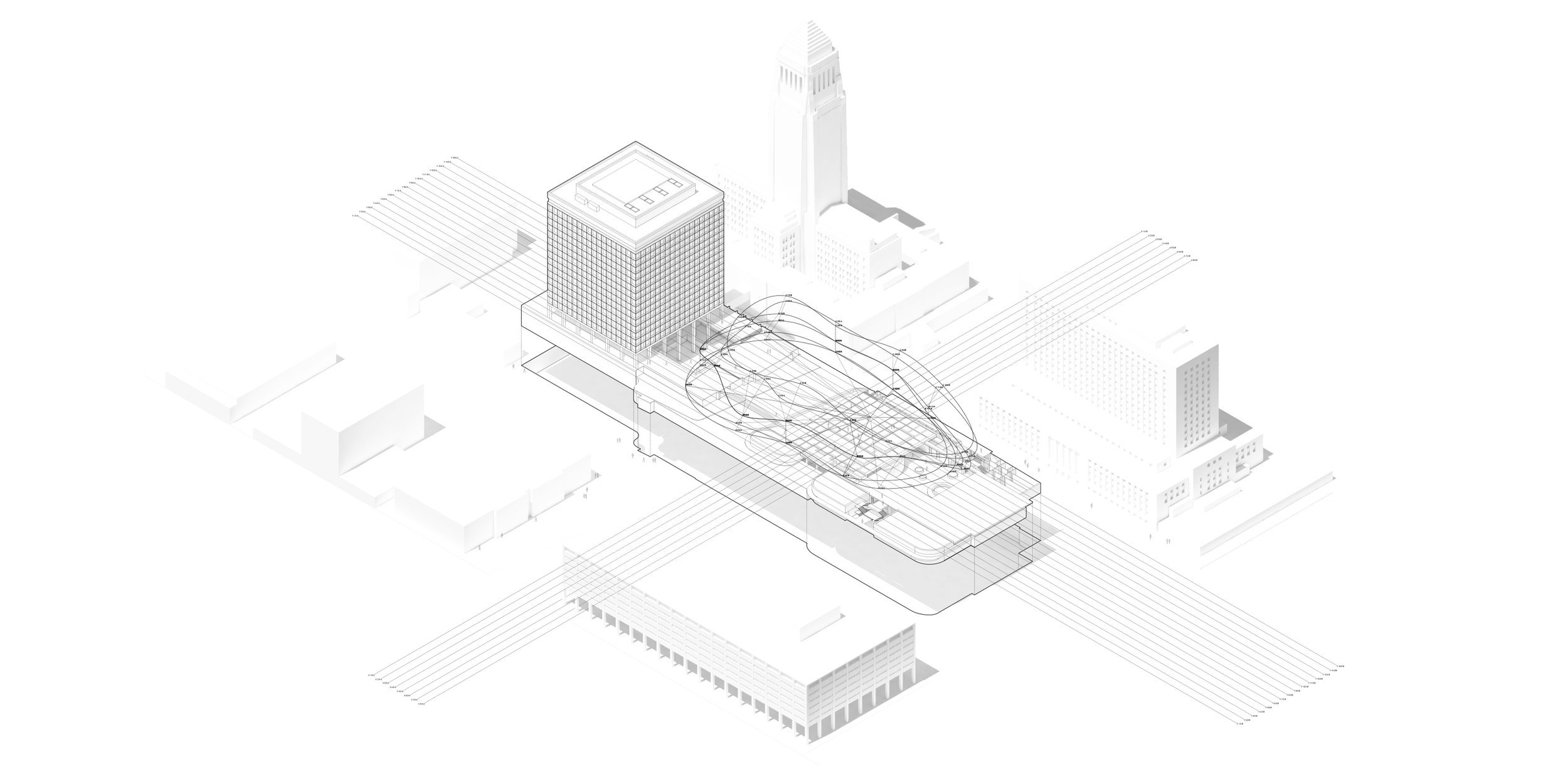Intensive Poche
Degree Project Woodbury University
Collaborators Mark Ericson, Duane Mclemore
Part I
Towards an Eccentric Architecture
Thesis Statement
Contemporary architecture has relinquished a significant aspect of architectural form, poche. By centering design on the liminal conditions of interior and exterior, the intermediary space has been relegated to structural, mechanical, and thermal concerns alone. In this manner, poche has been removed from architectural form. Poche is at the core of architecture both historically and in practice, contemporary architects should imbue it with meaning. This thesis began with an investigation into the poche in Church of St. Genevieve, Paris (1757), by the Architect Jacques-Germain Soufflott, and extrapolated a set of operations that embed the poche into the generation of architectural form. Specifically, rotational, and scalar shifting are deployed to explore the potential of an intensified poche, which is no longer understood as the residual of interior and exterior form, but rather as the center of all formal and spatial operations
In 1450 AD, Leon Battista Alberti wrote Descriptio urbis Romae with the intent of creating a new framework to understand encapsulate knowledge. At the time, artists and architects used drawings and paintings to represent their ideas. This practice becomes difficult to repeat with considerable levels of uniformity. Alberti believed if the logical sequence of reproducing a work could be abstracted down to a basic system, it would be transported, logically understood, and more accurately reproduced.
Fig. 01
Church of St. Genevieve - Place du Pantheon
Church of St. Genevieve
Post Revolutionary France changed the course of European governments for years to come. The overthrowing of the monarchy, a liberal federation was constructed. In its honor, a new future for France was created.
Fig. 02
Church of St. Genevieve - Triple Dome
Fig. 03
Church of St. Genevieve - Structural Pillar
Radial Explorations
A circle acts as the framework
Fig. 04
Radial Scalar Relationships - Low Variability
Fig. 05
Radial Scalar Relationships - High Variability
Vertical Scalar Variability
A circle acts as the framework
Fig. 06
Dome Variability - Triple Dome
Fig. 07
Dome Variability - Eccentricity in Section
Fig. 08
Dome Variability - Interstitial Space
Fig. 09
Dome Variability - Eccentricity in Plan
Planar Scalar Variability
A circle acts as the framework
Fig. 10
Dome Variability - Triple Dome
Fig. 11
Dome Variability - Eccentricity in Section
Fig. 12
Dome Variability - Interstitial Space
Fig. 13
Dome Variability - Eccentricity in Plan
Post Revolutionary France changed the course of European governments for years to come. The overthrowing of the monarchy, a liberal federation was constructed. In its honor, a new future for France was created.
Fig. 14
Church of St. Genevieve - Concentric vs Eccentric
Part II
Postulations of Poche
Contemporary architecture has relinquished a significant aspect of architectural form, poche. By centering design on the liminal conditions of interior and exterior, the intermediary space has been relegated to structural, mechanical, and thermal concerns alone. In this manner, poche has been removed from architectural form. Poche is at the core of architecture both historically and in practice, contemporary architects should imbue it with meaning. This thesis began with an investigation into the poche in Church of St. Genevieve, Paris (1757), by the Architect Jacques-Germain Soufflott, and extrapolated a set of operations that embed the poche into the generation of architectural form. Specifically, rotational, and scalar shifting are deployed to explore the potential of an intensified poche, which is no longer understood as the residual of interior and exterior form, but rather as the center of all formal and spatial operations
One of the first digital files was a map of Rome generated by Alberti in the mid 1400's. Alberti believed a map denoted to digits would travel better through space and time since manual copies could not preserve the correct portions of the original map. This was achieved by creating a device which would record points at a series of polar coordinates. The receiver of this digital code would then be expected to plot the points and create a new map which is identical to the first. This device is from Alberti's Descriptio urbis Romae.
These experiments were generated by deconstructed an circle by an arbitrary number of points. The area of the initial circle is the target domain of 0. The points move randomly on the domain on a polar array from the center of the circle, just like Alberti's device in Descriptio urbis Romae. These points are then interpolated by a NURBs curve to create a generated curve which can be scored against the optimal initial circle. The difference between the two shapes is the fitness function. More area is equal to poor fitness and less area is equal to optimal fitness. From here, the genetic algorithm is set and runs until it finds the best possible generation in the allotted time. The form is generated by the failed offspring, or those that seemed too unfit to reproduce. These failed curves are lofted from the less optimal to the most optimal to create a diagram of evolution.
These experiments were generated by deconstructed an circle by an arbitrary number of points. The area of the initial circle is the target domain of 0. The points move randomly on the domain on a polar array from the center of the circle, just like Alberti's device in Descriptio urbis Romae. These points are then interpolated by a NURBs curve to create a generated curve which can be scored against the optimal initial circle. The difference between the two shapes is the fitness function. More area is equal to poor fitness and less area is equal to optimal fitness. From here, the genetic algorithm is set and runs until it finds the best possible generation in the allotted time. The form is generated by the failed offspring, or those that seemed too unfit to reproduce. These failed curves are lofted from the less optimal to the most optimal to create a diagram of evolution.
Fig. 15
Paradox Interpolation - 3 Set
Fig. 16
Paradox Interpolation - 6 Set
Fig. 17
Paradox Interpolation - 11 Set
Fig. 10
2 Radii Poche - Serial Sections
Fig. 10
2 Radii Poche - Serial Sections
Fig. 10
2 Radii Poche - Serial Sections
Radii Studies
Fig. 12
Massing Study - 4 Radii Models
Fig. 13
Massing Study - 2 Radii Models
Fig. 14
Massing Study - 1 Radius Models
Part III
Intensive Poche
Kahn is arguing that certain materials perform better in different situations. Concrete has incredible compression strength but terrible tensile strength. Steel has incredible tensile strength and decent compression strength. When steel is added to concrete to create reinforced concrete, it becomes a composite material system that embodies both structural benefits. This is referred to as structural honesty.
Louis Sullivan was interested in creating the first true organic architecture. In 1896, he wrote, "It is the pervading law of all things organic and inorganic, of all things physical and metaphysical, of all things human, and all things super-human, of all true manifestations of the head, of the heart, of the soul, that the life is recognizable in its expression, that form ever follows function. This is the law." This quote is where form follows function originated. This is referred to as functional honesty.
As computers have taken over nearly every aspect of human life, architecture has also been quick to adopt them. Computational processes make quick work of otherwise time consuming drafting conventions. As the tools of creating architecture change from analog to digital, the formal language and process become more abstracted. This led me to a question by which I want to start my thesis, is this shift from analog to digital an honest representation of the material world?
While reading the Atlas of Novel Tectonics, I became interested with idea of Intensive Values versus Extensive Values. Intensive Values are non-quantifiable floating values that can't be rationalized by numbers. An example of these are gradients, forces, colors etc. Extensive values are quantifiable integers that can be rationalized by numbers. The world we live in is composed of both Intensive and Extensive Values. The digital world, down to the lowest level of abstraction is rationalized by 1's and 0's. Binary is Extensive, capacitors are Extensive. Computational Algorithms are Extensive. An Extensive tool will never be able to achieve the level of accuracy required to solve Intensive problems. So no, digital tools are not an honest representation of the analog world.
Even though computers are not able to honestly represent what is happening in the physical world, they are capable to compute exponentially complex problems. Richard Dawkins wanted to illustrate how organisms evolve over the course of multiple generations and created a simple genetic algorithm to do so. Biomorphs is an interactive gene pool simulator in which a user chooses two parents to mate. These parents are displayed as a collage of lines generated randomly in a symmetrical form to resemble some type of organism. As the user chooses which pairs will reproduce, the offspring develop both traits of the parents. Then the offspring reproduce and so on and so forth. This is a very crude but efficient example of a genetic algorithm.
Fig. 15
Los Angeles Mall
Fig. 16
Transformation of St. Genevieve Poche
Fig. 17
Transformation of St. Genevieve Poche
Fig. 18
Axonometric Section
Fig. 19
Plan/Section
Fig. 20
Thesis Review
Final Review
Recorded 04/29/2017
Special Thanks
Review Jurors
Mark Ericson
Duane McLemore
Dean Abernathy
Anthony Morey
Work Support
Alex Baur
Andrew Severin
Cole Masuno
Chris Straiter
Jayme Smith
Matthew Stutzke
Sam Lewis
























